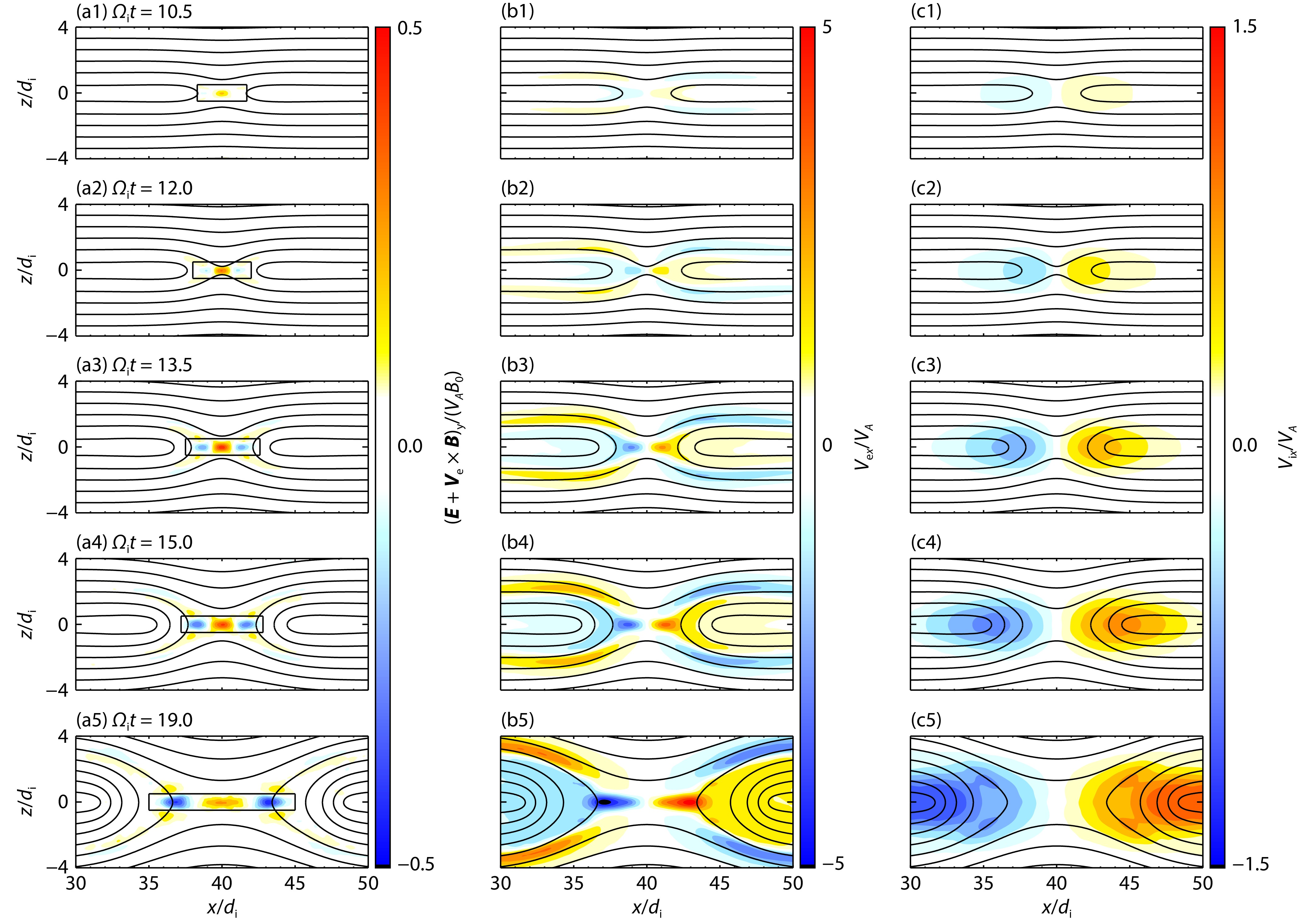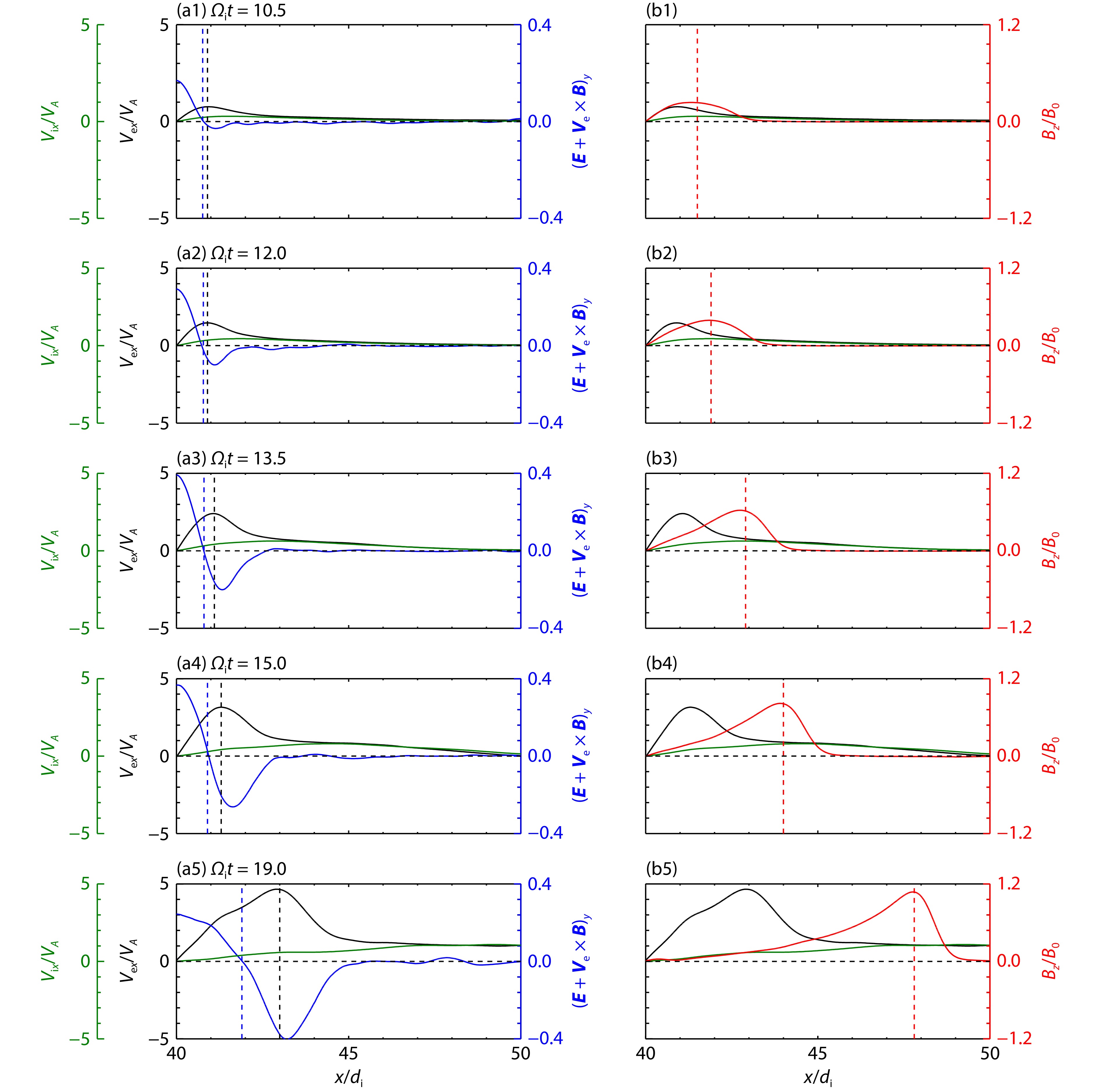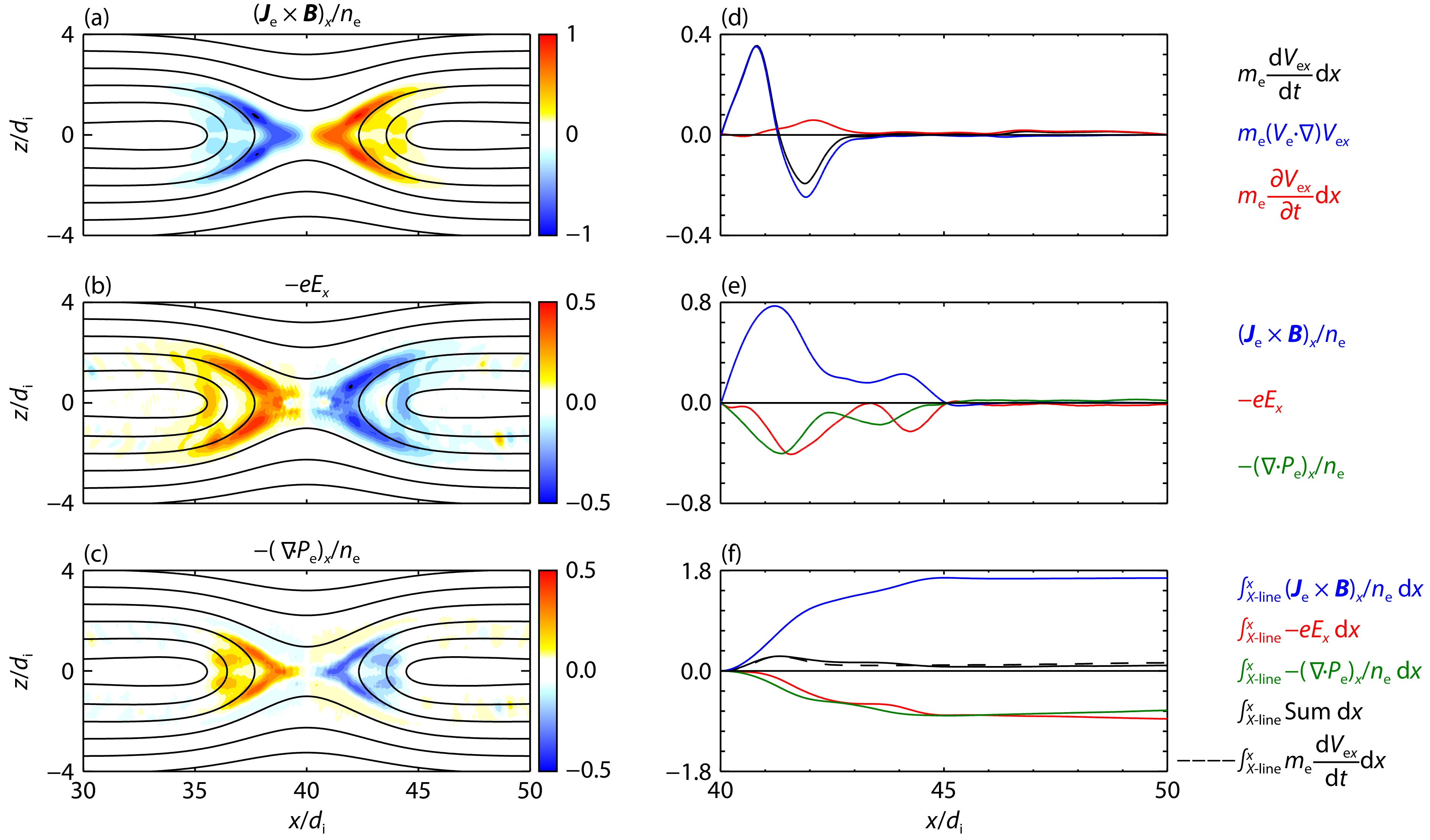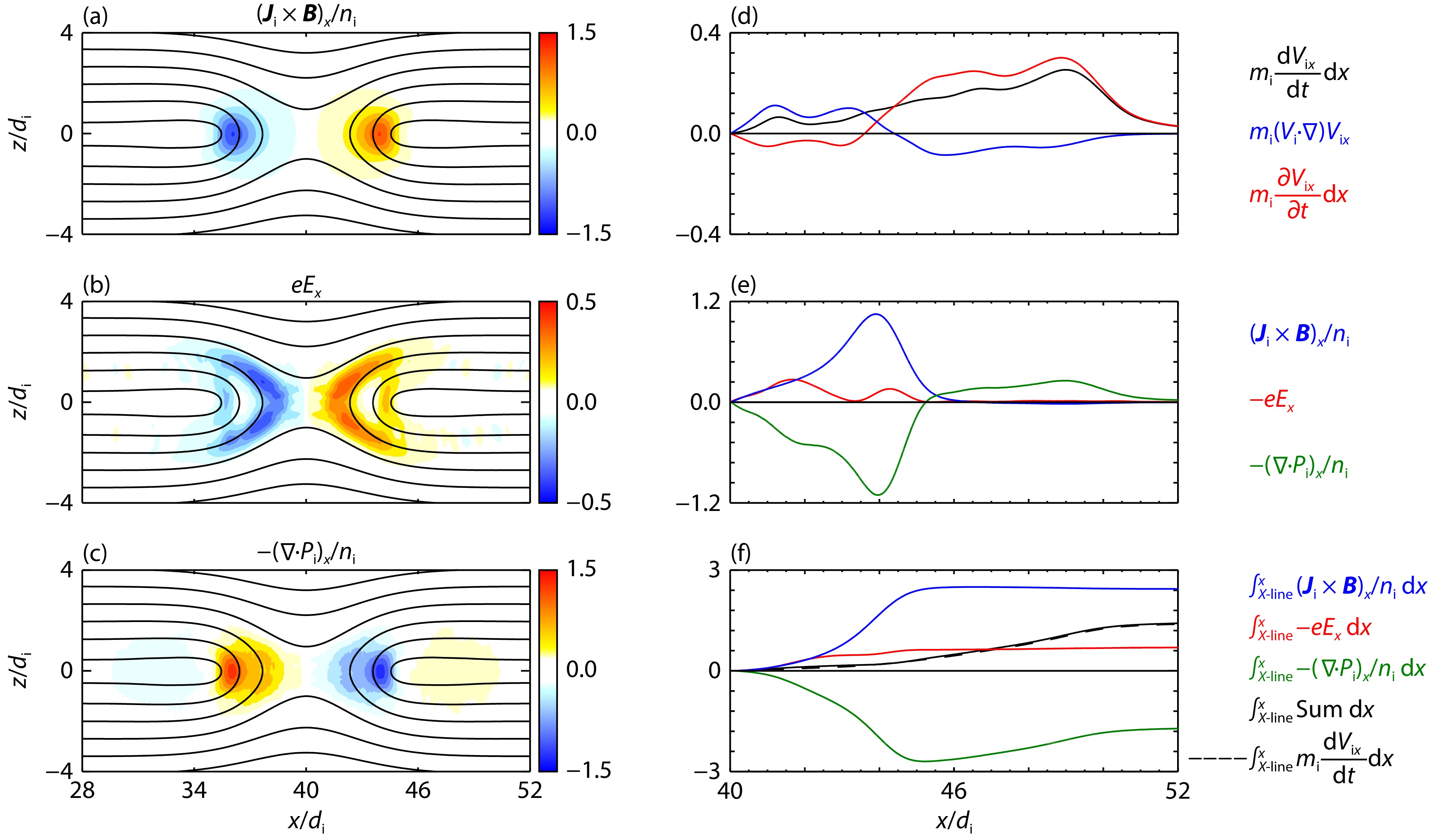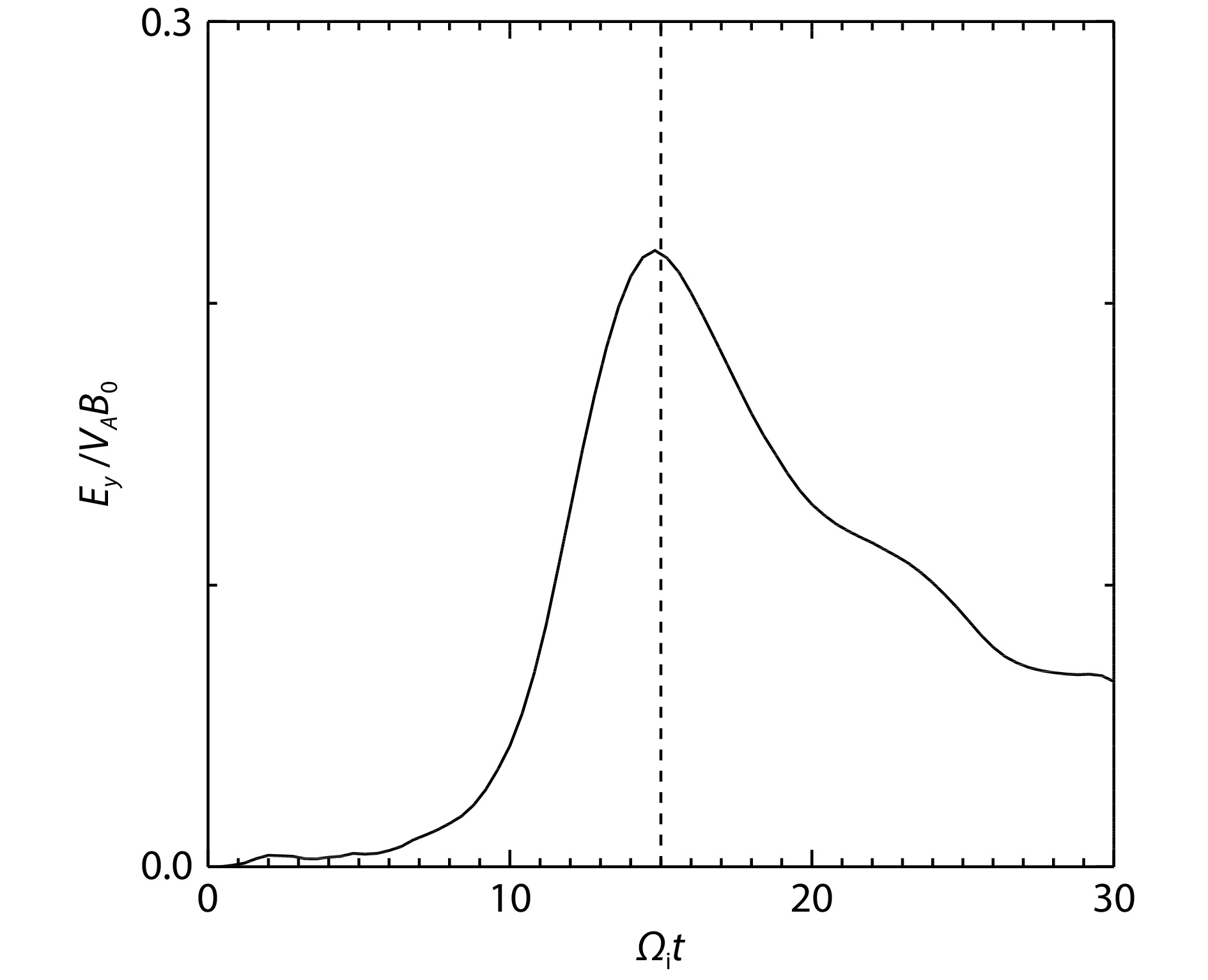
| Citation: | Chang, C., Lu, Q. M., Lu, S., Huang, K., and Wang, R. S. (2024). Ion and electron motions in the outer electron diffusion region of collisionless magnetic reconnection. Earth Planet. Phys., 8(3), 472–478. DOI: 10.26464/epp2024020 |
Two-dimensional particle-in-cell simulations are performed to study the coupling between ion and electron motions in collisionless magnetic reconnection. The electron diffusion region (EDR), where the electron motions are demagnetized, is found to have a two-layer structure: an inner EDR near the reconnection site and an outer EDR that is elongated to nearly 10 ion inertial lengths in the outflow direction. In the inner EDR, the speed of the electron outflow increases when the electrons move away from the X line. In the outer EDR, the speed of the electron outflow first increases and then decreases until the electrons reach the boundary of the outer EDR. In the boundary of the outer EDR, the magnetic field piles up and forms a depolarization front. From the perspective of the fluid, a force analysis on the formation of electron and ion outflows has also been investigated. Around the X line, the electrons are accelerated by the reconnection electric field in the out-of-plane direction. When the electrons move away from the X line, we find that the Lorentz force converts the direction of the accelerated electrons to the x direction, forming an electron outflow. Both electric field forces and electron gradient forces tend to drag the electron outflow. Ion acceleration along the x direction is caused by the Lorentz force, whereas the pressure gradient force tends to decelerate the ion outflow. Although these two terms are important, their effects on ions are almost offset. The Hall electric field force does positive work on ions and is not negligible. The ions are continuously accelerated, and the ion and electron outflow velocities are almost the same near the depolarization front.
Magnetic reconnection provides a physical mechanism for conversion from magnetic energy to plasma kinetic energy and thermal energy through topologic changes of the magnetic field lines (Parker, 1957; Sweet, 1958; Priest and Forbes, 2000; Yamada et al., 2010; Hesse and Cassak, 2020). It is widely accepted that various explosive phenomena, such as solar flares, coronal mass ejections, and magnetospheric substorms, are caused by magnetic reconnection (Masuda et al., 1994; Lin J and Forbes, 2000; Angelopoulos et al., 2008; Lu QM et al., 2022). The collisionless reconnection model, which provides a fast reconnection rate, is necessary to account for these phenomena. In collisionless magnetic reconnection, the collision frequency between charged particles is negligible; therefore, the motions between ions and electrons are decoupled (Birn and Hesse, 2001; Pritchett, 2001; Shay et al., 2007; Wang RS et al., 2010; Divin et al., 2012; Lu QM et al., 2013).
Collisionless magnetic reconnection has a multiscale structure (Birn and Hesse, 2001; Pritchett, 2001; Shay et al., 2001; Lu QM et al., 2010, 2013; Zong QG and Zhang H, 2018). The scale size below the electron inertial length
Recently, both particle-in-cell (PIC) simulations and satellite observations have found that the EDR has a multiscale structure: an inner EDR around the X line and an outer EDR with a length of several ion inertial lengths (Daughton et al., 2006; Phan et al., 2007; Shay et al., 2007; Divin et al., 2016). Karimabadi et al. (2007) indicated that the electron outflow velocity increases in the inner EDR and reaches a peak value near one electron Alfvén speed, whereas the outflow jet slows down gradually in the outer EDR. However, how the electron and ion outflows change in the inner and outer EDRs until they are coupled together in the far downstream is still unclear. In this article, a two-dimensional (2D) PIC simulation model is used to study the evolution of electron and ion outflows in the inner and outer EDRs by analyzing the contributions from the Lorentz force, the electric field force, and the pressure tensor term.
We use a 2D PIC simulation code, which has been successfully applied to study magnetic reconnection (Fu XR et al., 2006; Huang C et al., 2010; Lu QM et al., 2010; Chang C et al., 2021). In this model, particle motions are controlled by the electromagnetic field, and the electromagnetic field is updated by solving the Maxwell equations with an explicit leapfrog algorithm.
The initial equilibrium configuration is a Harris current sheet in the (x, z) plane (Harris, 1962), where the initial magnetic field and the corresponding number density are given by
| B(z)=B0tanh(z/δ)ex, | (1) |
| n=nb+n0sech2(z/δ), | (2) |
where
Figure 1 shows the time evolution of the reconnection rate, which is defined as the reconnection electric field
Figure 2 shows the evolution of a non-ideal electric field
To show the electron and ion outflows in the EDR more clearly, Figures 3a1–3a5 describe the profiles of the electron outflow velocity
To describe the electron outflow in detail, the distribution of forces on electrons that are considered fluids can be analyzed. The electron jet near the X line is almost along the x direction, and we consider only the x component of the electron momentum equation,
| medVexdt=−eEx+1ne(Je×B)x−1ne(∇⋅Pe)x. | (3) |
The terms on the right are the electric field force, Lorentz force, and electron pressure gradient force, respectively.
Figure 4 shows the x component of (a) the Lorentz force term, (b) the electric field force term, and (c) the electron pressure gradient force term at
| dVexdt=∂Vex∂t+(Ve⋅∇)Vex. |
The
| me∫xX-linedVexdtdl=−e∫xX-lineExdl+1ne∫xX-line(Je×B)xdl−1ne∫xX-line(∇⋅Pe)xdl, | (4) |
where the integration is calculated from the position X line to x. Figure 4f plots the profiles of the integrated terms in Equation (4), and we find that the two sides of the equation are almost balanced.
A similar force analysis is done on ions, and the x component of the ion momentum equation can be written as
| midVixdt=−eEx+1ni(Ji×B)x−1ni(∇⋅Pi)x. | (5) |
Figures 5a–5c show the three terms on the right side of Equation (5). On the right side of the X line, both the Lorentz force and the electric field force are positive such that the ion velocity increases to form an ion outflow, but the ion pressure gradient force is opposite (as shown in Figure 5e). Figure 5f plots the profiles of the integrated terms in Equation (5), and we can see that the black dashed curve and the black solid curve almost overlap, indicating that Equation (5) is satisfied well in our simulation. The sum of the three forces on the right side of Equation (5) is always positive, indicating that the ions are continuously accelerated. Although the Lorentz force and the ion pressure gradient force are much larger than the Hall electric field force, their effects on the ions are almost balanced. Therefore, the Hall electric field force, which does positive work on ions, is a small value but cannot be ignored. The spatial distribution of the outflow velocity corresponds to the
In this article, by performing a 2D PIC simulation, we identify the two-scale structure of the EDR in collisionless magnetic reconnection. The inner EDR is defined as the region where
After analyzing the x-component of the momentum equation, Liu DK et al. (2021) suggested that the ion outflow is dominated by the Lorentz force, whereas the pressure gradient force drags the ion outflow. The effect of the electric field force on the ion outflow is absent because the electric field force term is canceled out when the electron momentum equation and the ion momentum equation are added. Karimabadi et al. (2007) indicated that the ion acceleration within the inner EDR is due to the presence of electrostatic potential. The electrons are accelerated around the X line and then turned to the outflow direction by the Lorentz force, and the electrostatic potential acts to counteract this turning process. In our simulations, for ions, the electric field force and the Lorentz force are almost comparable within the inner EDR region, accelerating ions to form an ion outflow. In the outer EDR and the downstream region, the Lorentz force is much larger but almost completely balanced by the pressure gradient force, and the influence of the electric field force on ion acceleration cannot be ignored. For electrons, both the electric field force and the pressure gradient force can balance the Lorentz force. The pressure gradient force in the inner EDR region is slightly larger than the electric field force. This may be related to the initial electron temperature set in our simulations, which requires further investigation.
This work was supported by the National Key Research and Development Program of China (Grant No. 2022YFA1604600), the National Natural Science Foundation of China (NSFC, Grant No. 42174181), and the Strategic Priority Research Program of the Chinese Academy of Sciences (Grant No. XDB 41000000).
|
Angelopoulos, V., McFadden, J. P., Larson, D., Carlson, C. W., Mende, S. B., Frey, H., Phan, T., Sibeck, D. G., Glassmeier, K. H., … Kepko, L. (2008). Tail reconnection triggering substorm onset. Science, 321(5891), 931–935. https://doi.org/10.1126/science.1160495
|
|
Birn, J., and Hesse, M. (2001). Geospace Environment Modeling (GEM) magnetic reconnection challenge: resistive tearing, anisotropic pressure and Hall effects. J. Geophys. Res.: Space Phys., 106(A3), 3737–3750. https://doi.org/10.1029/1999JA001001
|
|
Cassak, P. A., Liu, Y. H., and Shay, M. A. (2017). A review of the 0.1 reconnection rate problem. J. Plasma Phys., 83(5), 715830501. https://doi.org/10.1017/S0022377817000666
|
|
Chang, C., Huang, K., Lu, Q. M., Sang, L. L., Lu, S., Wang, R. S., Gao, X. L., and Wang, S. (2021). Particle-in-cell simulations of electrostatic solitary waves in asymmetric magnetic reconnection. J. Geophys. Res.: Space Phys., 126(7), e2021JA029290. https://doi.org/10.1029/2021JA029290
|
|
Daughton, W., Scudder, J., and Karimabadi, H. (2006). Fully kinetic simulations of undriven magnetic reconnection with open boundary conditions. Phys. Plasmas, 13(7), 072101. https://doi.org/10.1063/1.2218817
|
|
Divin, A., Lapenta, G., Markidis, S., Semenov, V. S., Erkaev, N. V., Korovinskiy, D. B., and Biernat, H. K. (2012). Scaling of the inner electron diffusion region in collisionless magnetic reconnection. J. Geophys. Res.: Space Phys., 117(A6), A06217. https://doi.org/10.1029/2011JA017464
|
|
Divin, A., Semenov, V., Korovinskiy, D., Markidis, S., Deca, J., Olshevsky, V., and Lapenta, G. (2016). A new model for the electron pressure nongyrotropy in the outer electron diffusion region. Geophys. Res. Lett., 43(20), 10565–10573. https://doi.org/10.1002/2016GL070763
|
|
Drake, J. F., Shay, M. A., Thongthai, W., and Swisdak, M. (2005). Production of energetic electrons during magnetic reconnection. Phys. Rev. Lett., 94(9), 095001. https://doi.org/10.1103/PhysRevLett.94.095001
|
|
Fu, X. R., Lu, Q. M., and Wang, S. (2006). The process of electron acceleration during collisionless magnetic reconnection. Phys. Plasmas, 13(1), 012309. https://doi.org/10.1063/1.2164808
|
|
Harris, E. G. (1962). On a plasma sheath separating regions of oppositely directed magnetic field. Nuovo Cimento, 23(1), 115–121. https://doi.org/10.1007/BF02733547
|
|
Hesse, M., Zenitani, S., Kuznetsova, M., and Klimas, A. (2009). A simple, analytical model of collisionless magnetic reconnection in a pair plasma. Phys. Plasmas, 16(10), 102106. https://doi.org/10.1063/1.3246005
|
|
Hesse, M., and Cassak, P. A. (2020). Magnetic reconnection in the space sciences: past, present, and future. J. Geophys. Res.: Space Phys., 125(2), e2018JA025935. https://doi.org/10.1029/2018JA025935
|
|
Huang, C., Lu, Q. M., and Wang, S. (2010). The mechanisms of electron acceleration in antiparallel and guide field magnetic reconnection. Phys. Plasmas, 17(7), 072306. https://doi.org/10.1063/1.3457930
|
|
Karimabadi, H., Daughton, W., and Scudder, J. (2007). Multi-scale structure of the electron diffusion region. Geophys. Res. Lett., 34(13), L13104. https://doi.org/10.1029/2007GL030306
|
|
Lin, J., and Forbes, T. G. (2000). Effects of reconnection on the coronal mass ejection process. J. Geophys. Res.: Space Phys., 105(A2), 2375–2392. https://doi.org/10.1029/1999JA900477
|
|
Liu, D. K., Huang, K., Lu, Q. M., Lu, S., Wang, R. S., Ding, W. X., and Wang, S. (2021). The evolution of collisionless magnetic reconnection from electron scales to ion scales. Astrophys. J., 922(1), 51. https://doi.org/10.3847/1538-4357/ac2900
|
|
Liu, Y. H., Hesse, M., Guo, F., Daughton, W., Li, H., Cassak, P. A., and Shay, M. A. (2017). Why does steady-state magnetic reconnection have a maximum local rate of order 0.1?. Phys. Rev. Lett., 118(8), 085101. https://doi.org/10.1103/PhysRevLett.118.085101
|
|
Lu, Q. M., Huang, C., Xie, J. L., Wang, R. S., Wu, M. Y., Vaivads, A., and Wang, S. (2010). Features of separatrix regions in magnetic reconnection: comparison of 2-D particle-in-cell simulations and Cluster observations. J. Geophys. Res.: Space Phys., 115(A11), A11208. https://doi.org/10.1029/2010JA015713
|
|
Lu, Q. M., Lu, S., Huang, C., Wu, M. Y., and Wang, S. (2013). Self-reinforcing process of the reconnection electric field in the electron diffusion region and onset of collisionless magnetic reconnection. Plasma Phys. Control. Fusion, 55(8), 085019. https://doi.org/10.1088/0741-3335/55/8/085019
|
|
Lu, Q. M., Fu, H. S., Wang, R. S., and Lu, S. (2022). Collisionless magnetic reconnection in the magnetosphere. Chin. Phys. B, 31(8), 089401. https://doi.org/10.1088/1674-1056/ac76ab
|
|
Lu, S., Angelopoulos, V., Pritchett, P. L., Nan, J., Huang, K., Tao, X., Artemyev, A. V., Runov, A., Jia, Y. D., … Kang, N. (2021). Electrodynamic contributions to the Hall- and parallel electric fields in collisionless magnetic reconnection. J. Geophys. Res.: Space Phys., 126(11), e2021JA029550. https://doi.org/10.1029/2021JA029550
|
|
Masuda, S., Kosugi, T., Hara, H., Tsuneta, S., and Ogawara, Y. (1994). A loop-top hard X-ray source in a compact solar flare as evidence for magnetic reconnection. Nature, 371(6497), 495–497. https://doi.org/10.1038/371495a0
|
|
Nagai, T., Shinohara, I., Fujimoto, M., Machida, S., Nakamura, R., Saito, Y., and Mukai, T. (2003). Structure of the Hall current system in the vicinity of the magnetic reconnection site. J. Geophys. Res.: Space Phys., 108(A10), 1357. https://doi.org/10.1029/2003JA009900
|
|
Parker, E. N. (1957). Sweet’s mechanism for merging magnetic fields in conducting fluids. J. Geophys. Res.: Space Phys., 62(4), 509–520. https://doi.org/10.1029/JZ062i004p00509
|
|
Phan, T. D., Drake, J. F., Shay, M. A., Mozer, F. S., and Eastwood, J. P. (2007). Evidence for an elongated (>60 ion skin depths) electron diffusion region during fast magnetic reconnection. Phys. Rev. Lett., 99(25), 255002. https://doi.org/10.1103/PhysRevLett.99.255002
|
|
Priest, E., and Forbes, T. (2000). Magnetic Reconnection: MHD Theory and Applications. Cambridge: Cambridge University Press. https://doi.org/10.1017/CBO9780511525087
|
|
Pritchett, P. L. (2001). Geospace environment modeling magnetic reconnection challenge: simulations with a full particle electromagnetic code. J. Geophys. Res.: Space Phys., 106(A3), 3783–3798. https://doi.org/10.1029/1999JA001006
|
|
Shay, M. A., Drake, J. F., Rogers, B. N., and Denton, R. E. (2001). Alfvénic collisionless magnetic reconnection and the Hall term. J. Geophys. Res.: Space Phys., 106(A3), 3759–3772. https://doi.org/10.1029/1999JA001007
|
|
Shay, M. A., Drake, J. F., and Swisdak, M. (2007). Two-scale structure of the electron dissipation region during collisionless magnetic reconnection. Phys. Rev. Lett., 99(15), 155002. https://doi.org/10.1103/PhysRevLett.99.155002
|
|
Sweet, P. A. (1958). The neutral point theory of solar flares. Symp. Int. Astron. Union, 6, 123–134. https://doi.org/10.1017/S0074180900237704
|
|
Wang, R. S., Lu, Q. M., Huang, C., and Wang, S. (2010). Multispacecraft observation of electron pitch angle distributions in magnetotail reconnection. J. Geophys. Res.: Space Phys., 115(A1), A01209. https://doi.org/10.1029/2009JA014553
|
|
Wang, S., Chen, L. J., Bessho, N., Kistler, L. M., Shuster, J. R., and Guo, R. L. (2016). Electron heating in the exhaust of magnetic reconnection with negligible guide field. J. Geophys. Res.: Space Phys., 121(3), 2104–2130. https://doi.org/10.1002/2015JA021892
|
|
Yamada, M., Kulsrud, R., and Ji, H. T. (2010). Magnetic reconnection. Rev. Mod. Phys., 82(1), 603–644. https://doi.org/10.1103/RevModPhys.82.603
|
|
Zong, Q.-G., and Zhang H. (2018). In situ detection of the electron diffusion region of collisionless magnetic reconnection at the high-latitude magnetopause. Earth Planet. Phys., 2(3), 231–237. https://doi.org/10.26464/epp2018022
|
| 1. | Huang, S.Y., Xiong, Q.Y., Jiang, K. et al. Recent advances on kinetic simulations and observations of electron diffusion region during magnetic reconnection in space plasmas. Reviews of Modern Plasma Physics, 2025, 9(1): 4. DOI:10.1007/s41614-025-00179-6 | |
| 2. | Hu, S., Lu, Q., Guan, Y. et al. Particle-in-cell Simulation of Electromagnetic Field Structure in the Electron-only Reconnection | [电子重联中电磁场结构的粒子模拟]. Chinese Journal of Space Science, 2024, 44(6): 970-978. DOI:10.11728/cjss2024.06.2024-yg31 |
